2. 山东省农业科学院家禽研究所, 济南 250023
2. Poultry Institute, Shandong Academy of Agricultural Sciences, Jinan 250023, China
随着畜禽养殖规模的不断增加和集约化养殖方式的快速发展, 大量畜禽粪尿集中排放, 挥发的氨气不仅对环境造成巨大的污染, 同时也严重影响畜禽的健康, 诱发各种疾病, 导致生产性能下降, NH3排放污染严重制约了我国畜禽养殖的可持续发展。畜禽养殖过程中排放的NH3通常来源于动物肠道消化以及舍内堆积的粪尿、饲料残渣和垫料等有机物的腐败、分解过程。我国是世界上最大的禽蛋生产国和消费国, 禽蛋生产以鸡蛋为主。根据联合国粮农组织(FAO)统计, 2006-2013年全球鸡蛋平均产量为6328万t, 我国鸡蛋平均产量为2340万t, 占全球总产量的37%。根据《中国畜牧业年鉴》统计, 截至2012年底, 我国年存栏量≥1万只的规模化蛋鸡养殖场达39 135个, 其中北京、天津、河北、山西、山东、河南6省(市)16 605个, 占全国总数的42.4%, 仅山东省就有5236个, 占上述地区总量的31.5%, 是我国北方地区名副其实的蛋鸡养殖大省。集约化蛋鸡养殖场是农业源有害气体NH3的重要排放源之一[1-4]。蛋鸡舍内NH3对于蛋鸡眼部、呼吸道黏膜有强烈的刺激作用[5-9], 可引起角膜炎、结膜炎、上呼吸道黏膜充血、水肿等疾病[10-11], 造成蛋鸡的采食量下降, 对疾病的抵抗力减弱, 生产能力下降[12-13], 严重时会导致呼吸中枢麻痹甚至死亡。鸡舍环境中的NH3已成为影响人畜健康的重要污染物[14-15]。本试验基于对密闭笼养蛋鸡舍内NH3浓度的定期测定, 分析其变化规律及其与环境因子之间的相互关系, 为蛋鸡养殖环境调控、污染物减量、养殖模式优化等提供理论依据。
1 材料与方法 1.1 试验鸡舍本试验在济南鸣任畜牧养殖有限公司养殖基地进行, 该基地位于济南市天桥区大桥镇大刘村。试验鸡舍为砖混鸡舍, 南北走向, 舍长75 m, 舍宽8.5 m, 舍高4.4 m, 东西两侧墙高3.5 m, 双坡式屋顶, 中间有10 cm厚的保温层, 屋顶高0.9 m。东西两侧墙上3 m高度处各有13个通风管道, 22个窗户, 单个窗户面积为0.8 m2, 窗户离地高度为2.3 m, 墙厚度为24 cm。舍内采用纵向通风, 南山墙设有0.75 kW和1.5 kW的风机各3个, 风机直径分别为1.1 m和1.75 m, 通风量分别为30 000 m3·h-1和40 000 m3·h-1, 北山墙设有湿帘5个, 总面积22 m2。沿舍内长轴两侧放置2列全阶梯鸡笼, 鸡笼总长66 m, 北墙湿帘距鸡笼8 m, 南墙风机距鸡笼1 m。试验鸡舍自动化管理水平较高, 采用自动喂料器、智能光控系统、乳头式自动饮水器、自动捡蛋设备, 清粪方式采用电动刮粪板, 粪道宽2.1 m, 走道宽1.5 m。养殖规模8160只。监测期鸡舍内蛋鸡为110~420日龄。
1.2 鸡舍饲养管理试验鸡舍每日定时喂料2次, 分别在6:00-7:00与17:00-18:00两个时间段进行。舍内每日定时自动清粪2次, 分别在6:00-6:30与17:00-17:30两个时间段进行。冬季舍内每周喷雾消毒1次。
1.3 主要仪器设备试验所用仪器设备是由河北农业大学自主研发的便携式畜禽舍环境动态监测仪。该设备是基于物联网的畜禽舍环境监测系统, 采用进口高精度传感器, 具备内置式采样泵, 采用抽气式气体检测方式; 温度检测量程为-40~85℃, 分辨率为±0.3℃, 相对湿度检测量程为0~100%, 分辨率为±0.5%, NH3浓度检测量程为0~100 mg·m-3, 分辨率为0.1 mg·m-3。该仪器可对舍内温湿度和NH3浓度进行连续监测和记录。
1.4 主要测试内容试验过程中主要对试验鸡舍内的温度、相对湿度和NH3浓度进行连续监测, 同时对鸡舍内的饲养过程进行详细记录。
1.5 测试时间试验期为2015年9月22日-2016年8月23日, 每个月监测一次, 每次连续监测3~5 d, 保证3 d数据有效, 每日连续监测24 h, 每5 min记数一次。
1.6 监测点位布置沿着鸡舍内的风向, 分别在鸡舍内鸡笼长度三等分点, 即在鸡舍中部走廊距离北墙8 m处(近门端)、41 m处(舍中间)和74 m处(风机端)各布设一个监测点, 并依据人体呼吸的平均高度, 确定监测点距离地面高度为1.5 m (图 1)。

|
图 1 舍内监测点位布设示意图 Figure 1 The layout of the monitoring points |
试验鸡舍内共设置3个采样点, 取3个点的平均值代表整栋鸡舍的指标值; 监测数据记录间隔为5 min, 将每小时记录的12个数取平均值, 代表当日每小时的NH3平均浓度, 每季度连续3 d的数据采用同样的处理方式, 再将3 d的数取平均值, 代表当季NH3日平均浓度。
2 结果与讨论 2.1 不同季节鸡舍内温湿度的变化不同季节鸡舍内温度和湿度的变化情况见表 1。由表 1可知, 随着日龄的增加, 试验鸡舍内同一季节沿水平方向的温度和湿度基本平稳, 但不同季节表现出明显的差异。日平均温度春季为20.9℃、夏季为24.3℃、秋季为20.4℃, 冬季为14.7℃, 日平均相对湿度春季为37.7%、夏季为70.7%、秋冬季为52.6%。不同季节鸡舍内日平均温度和日平均相对湿度逐时变化情况如图 2、图 3所示。从图中可以看出, 鸡舍内温度白天略高于夜间, 相对湿度则刚好相反, 夜间略高于白天, 从季节来看, 夏季高温高湿, 春季中温干燥, 秋季温湿度适宜, 冬季低温低湿, 总体来看试验鸡舍内的温度和相对湿度较为适宜, 完全符合《畜禽场环境质量标准》(NY/T 388-1999)中的规定和要求。杨选将等[16]对八层层叠式笼养蛋鸡舍夏季的环境质量参数进行测定, 分析不同位置的参数差异, 结果表明, 从湿帘端至风机端舍内温度和相对湿度分布均匀。申李琰等[17-18]对层叠式立体笼养肉鸡舍内秋冬季节的环境参数进行测定, 分析不同季节的环境参数差异, 结果表明:冬季舍内温度略高于秋季, 秋季舍内相对湿度显著高于冬季, 两个季节的温湿度均可满足不同日龄肉鸡生长需要。
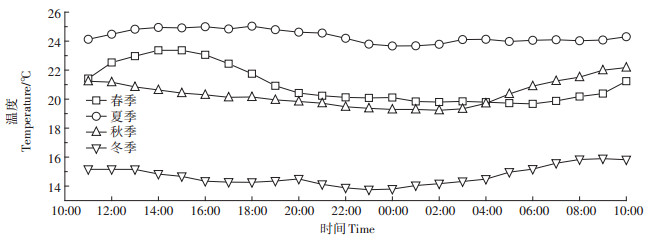
|
图 2 不同季节鸡舍内温度逐时变化情况 Figure 2 Hourly change of temperature in layer house in different seasons |
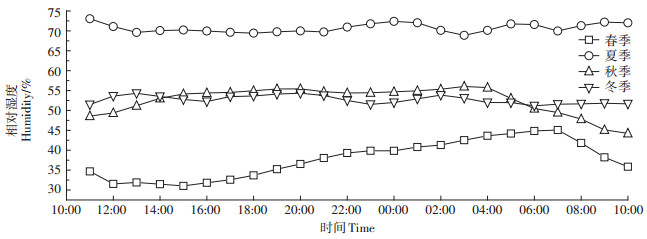
|
图 3 不同季节鸡舍内相对湿度逐时变化情况 Figure 3 Hourly change of humidity in layer house in different seasons |
|
|
表 1 不同季节鸡舍内的温湿度 Table 1 Temperature and humidity in layer house in different seasons |
不同季节鸡舍内NH3浓度的变化情况见表 2。由表 2可知, 随着日龄的增加, 试验鸡舍内同一季节沿水平方向的氨气浓度存在一定的差异, 不同季节差异尤为明显。鸡舍内NH3日平均浓度夏季极低, 为0.03 mg·m-3, 其原因在于2016年夏季监测期间30℃以上高温天数多达68 d, 鸡舍大小风机一般24 h运转, 舍内通风量达到极值, 舍内NH3被最大限度地排出舍外。济南春季较短, 气温回升较快, 气温25℃以上的天数为36 d, 28~34℃的天数为21 d, 鸡舍通风量高于秋季和冬季, 所以春季近门端(与舍外大气相通) NH3浓度远低于舍中间和风机端, NH3日平均浓度为2.46 mg·m-3。秋冬季舍中间NH3浓度远高于近门端和风机端, NH3日平均浓度分别为4.72 mg·m-3和3.05 mg·m-3。不同季节鸡舍内NH3日平均浓度变化情况如图 4所示。从图中可以看出, 夏季和冬季鸡舍内NH3浓度白天和夜间基本保持一致, 春季和秋季夜间明显高于白天, 从季节来看, 秋季鸡舍内NH3浓度最高, 其次是冬季和春季, 夏季最低, 根据《畜禽场环境质量标准》(NY/T 388-1999), 禽舍内NH3浓度的限定值为15 mg·m-3, 由此可见, 试验鸡舍内NH3浓度完全达标。
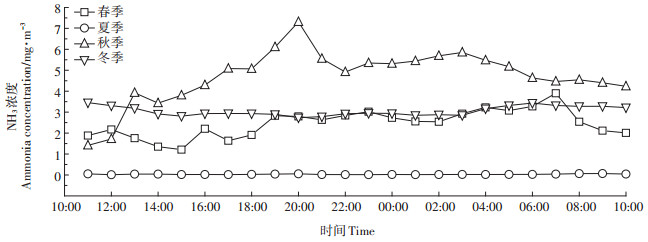
|
图 4 不同季节鸡舍内NH3浓度逐时变化情况 Figure 4 Hourly change of ammonia concentration in layer house in different seasons |
|
|
表 2 不同季节鸡舍内日平均NH3浓度(mg·m-3) Table 2 Daily mean ammonia concentration in layer house in different seasons (mg·m-3) |
研究表明鸡舍内的通风换气和温湿度调节会影响NH3浓度的显著变化。不同季节鸡舍内NH3浓度与温湿度之间的相关性如图 5~图 10所示。春季鸡舍内NH3浓度与温度呈负相关, 与相对湿度呈正相关; 秋季也存在同样的相关性; 冬季相关性则恰恰相反, 与温度呈正相关, 与相对湿度呈负相关。由此可见, 在高温条件下, 鸡舍内NH3浓度随湿度的升高而增高, 而在低温条件下, 鸡舍内NH3浓度则随湿度的升高而降低, 环境的温湿度对鸡舍内NH3浓度影响很大。程秀花等[19]对冬季密闭鸡舍内温湿度与NH3浓度的相关性进行研究, 结果表明, 鸡舍内温度与NH3浓度呈线性关系, 且相关性较强, 而相对湿度与NH3浓度没有相关性, 说明冬季鸡舍内NH3浓度主要受温度影响, 而相对湿度对NH3浓度的影响不明显。本研究结果表明, 不同季节鸡舍内NH3浓度与温度和相对湿度均呈现一定的相关性, 而春季中温干燥情况下的相关性最强, 其次是低温低湿的冬季, 秋季温湿度适宜, 相关性不是很明显。因此, 对于鸡舍内温湿度的科学管理和合理调节是降低舍内NH3浓度的关键。

|
图 5 春季鸡舍内NH3浓度与温度的相关性 Figure 5 The correlation of ammonia concentration and temperature in the spring |
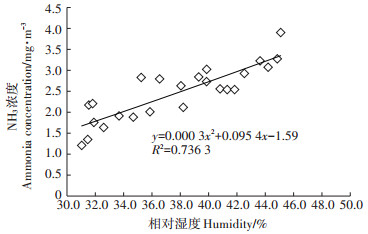
|
图 6 春季鸡舍内NH3浓度与相对湿度的相关性 Figure 6 The correlation of ammonia concentration and humidity in the spring |
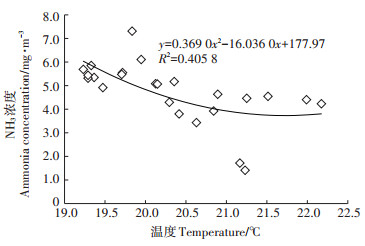
|
图 7 秋季鸡舍内NH3浓度与温度的相关性 Figure 7 The correlation of ammonia concentration and temperature in the autumn |
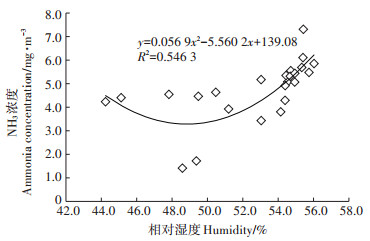
|
图 8 秋季鸡舍内NH3浓度与相对湿度的相关性 Figure 8 The correlation of ammonia concentration and humidity in the autumn |
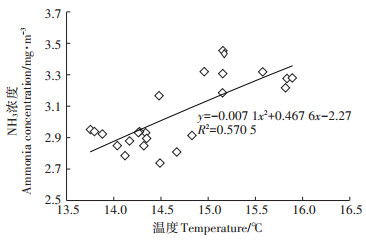
|
图 9 冬季鸡舍内NH3浓度与温度的相关性 Figure 9 The correlation of ammonia concentration and temperature in the winter |
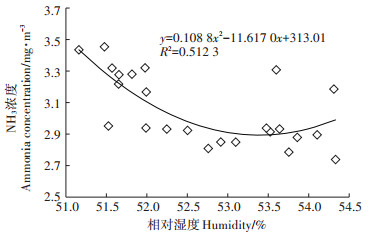
|
图 10 冬季鸡舍内NH3浓度与相对湿度的相关性 Figure 10 The correlation of ammonia concentration and humidity in the winter |
(1) 鸡舍内日平均温度春季为(20.9±1.3)℃, 夏季为(24.3±0.8)℃, 秋季为(20.4±0.9)℃, 冬季为(14.7±0.9)℃; 日平均相对湿度春季为(37.7±4.9)%, 夏季为70.7%±3.0%, 秋季为52.6%±3.4%, 冬季为52.6%±1.6%, 完全符合《畜禽场环境质量标准》(NY/T 388-1999)中的规定和要求。
(2) 夏季鸡舍内NH3日平均浓度为(0.03±0.02) mg·m-3, 春季为(2.46±1.01) mg·m-3, 且近门端远低于舍中间和风机端, 秋冬季分别为(4.72±1.73) mg·m-3和(3.05±0.41) mg·m-3, 且舍中间远高于近门端和风机端。粪便及时清出可有效降低鸡舍内NH3浓度。
(3) 鸡舍内NH3浓度与温度和相对湿度均呈现一定的相关性, 春季中温干燥情况下相关性最强, 其次是低温低湿的冬季, 秋季温湿度适宜, 相关性较弱。环境的温湿度对鸡舍内NH3浓度影响很大, 对鸡舍内温湿度的科学管理和合理调节是降低舍内NH3浓度的重要因素。
| [1] |
Fabbri C, Valli L, Guarino M, et al. Ammonia, methane, nitrous oxide and particulate matter emissions from two different buildings for laying hens[J]. Biosystems Engineering, 2007, 97(4): 441-455. DOI:10.1016/j.biosystemseng.2007.03.036 |
| [2] |
王占文, 邓力, 于福贵, 等. 早春季节畜禽舍内有害气体产生的原因、危害及防控措施[J]. 中国畜牧兽医文摘, 2017, 33(1): 100. WANG Zhan-wen, DENG Li, YU Fu-gui, et al. Reasons, hazards and control measures of harmful gases in livestock houses during early spring season[J]. China Animal Husbandry and Veterinary Abstracts, 2017, 33(1): 100. |
| [3] |
张石锐.畜禽生产环境中主要有害气体监测方法研究[D].上海: 上海交通大学, 2014. ZHANG Shi-rui. Monitoring methods research for harmful gases in livestock production environment[D]. Shanghai: Shanghai Jiao Tong University, 2014. http://cdmd.cnki.com.cn/Article/CDMD-10248-1015033303.htm |
| [4] |
张莹莹, 刘春青, 刘晓辉, 等. 畜禽舍有害气体的来源及其常用消毒方法[J]. 饲料博览, 2014(3): 11-13. ZHANG Ying-ying, LIU Chun-qing, LIU Xiao-hui, et al. The source of harmful gas in livestock environment and disinfection methods[J]. Feed Review, 2014(3): 11-13. |
| [5] |
Meda B, Hassouna M, Aubert C, et al. Influence of rearing conditions and manure management practices on ammonia and greenhouse gas emissions from poultry houses[J]. World's Poultry Science Journal, 2011, 67(3): 441-456. DOI:10.1017/S0043933911000493 |
| [6] |
Fournel S, Pelletier F, Godbout S, et al. Odour emissions, hedonic tones and ammonia emissions from three cage layer housing systems[J]. Biosystems Engineering, 2012, 112(3): 181-191. DOI:10.1016/j.biosystemseng.2012.03.010 |
| [7] |
Ni J Q, Chai L L, Chen L D, et al. Characteristics of ammonia, hydrogen sulfide, carbon dioxide, and particulate matter concentrations in high-rise and manure-belt layer hen houses[J]. Atmospheric Environment, 2012, 57: 165-174. DOI:10.1016/j.atmosenv.2012.04.023 |
| [8] |
Le Bouquin S, Huneau-Salaun A, Huonnic D, et al. Aerial dust concentration in cage-housed, floor-housed, and aviary facilities for laying hens[J]. Poultry Science, 2013, 92(11): 2827-2833. DOI:10.3382/ps.2013-03032 |
| [9] |
宋弋, 王忠, 姚中磊, 等. 氨气对肉鸡生产性能、血氨和尿酸的影响研究[J]. 中国家禽, 2008, 30(13): 10-16. SONG Yi, WANG Zhong, YAO Zhong-lei, et al. Effects of atmospheric ammonia on growth performance, plasma ammonia and uric acid in broilers[J]. China Poultry, 2008, 30(13): 10-16. |
| [10] |
吴迪梅, 刘薇, 张丽丽. 氨气对肉鸡生产性能的影响[J]. 北京农业, 2012(9): 42-44. WU Di-mei, LIU Wei, ZHANG Li-li. Ammonia to chicken production performance influence[J]. Beijing Agriculture, 2012(9): 42-44. |
| [11] |
Zhao Y, Xin H W, Timothy A, et al. Thermal environment, ammonia concentrations, and ammonia emissions of aviary houses with white laying hens[J]. Transactions of the ASABE, 2013, 56(3): 1145-1156. |
| [12] |
Kilic I, Yaslioglu E. Ammonia and carbon dioxide concentrations in a layer house[J]. Asian-Australasian Journal of Animal Sciences, 2014, 27(8): 1211-1218. DOI:10.5713/ajas.2014.14099 |
| [13] |
邵丹, 贺娇, 施寿荣, 等. 垫料厚度对鸡舍氨气、二氧化碳和粉尘的影响[J]. 中国家禽, 2015, 37(1): 59-60. SHAO Dan, HE Jiao, SHI Shou-rong, et al. Effects of bedding thickness on ammonia, carbon dioxide and dust in a layer house[J]. China Poultry, 2015, 37(1): 59-60. |
| [14] |
王世鹏, 毛罕平, 王新忠, 等. 冬季鸡舍内NH3的空间分布规律[J]. 畜牧与兽医, 2008, 40(10): 52-55. WANG Shi-peng, MAO Han-ping, WANG Xin-zhong, et al. Distribution of NH3 in poultry houses in winter[J]. Animal Husbandry & Veterinary Medicine, 2008, 40(10): 52-55. |
| [15] |
李琴, 刘鹏, 刘中英, 等. 影响鸡舍氨气排放的主要因素[J]. 中国家禽, 2017, 39(5): 45-49. LI Qin, LIU Peng, LIU Zhong-ying, et al. Main factors influencing the ammonia emission of poultry house[J]. China Poultry, 2017, 39(5): 45-49. |
| [16] |
杨选将, 刘盛楠, 詹凯, 等. 八层层叠式笼养蛋鸡舍夏季环境质量参数测定与相关性分析[J]. 中国家禽, 2015, 37(10): 26-29. YANG Xuan-jiang, LIU Sheng-nan, ZHAN Kai, et al. Measurement of environmental quality parameters and its correlation analysis of layer house with eight overlap tiers cages in summer[J]. China Poultry, 2015, 37(10): 26-29. |
| [17] |
申李琰, 萨仁娜, 牛晋国, 等. 层叠式立体笼养肉鸡舍秋冬季节环境参数研究[J]. 中国畜牧兽医, 2017, 44(5): 1565-1570. SHEN Li-yan, SAREN Na, NIU Jin-guo, et al. Study on environmental quality parameters in broiler house with three-overlap cages in winter and autumn[J]. China Animal Husbandry & Veterinary Medicine, 2017, 44(5): 1565-1570. |
| [18] |
申李琰, 牛晋国, 刘文革, 等. 层叠式立体笼养肉鸡舍环境参数分布规律研究[J]. 中国家禽, 2016, 38(18): 37-41. SHEN Li-yan, NIU Jin-guo, LIU Wen-ge, et al. Study on distribution characteristics of environmental quality parameters in broiler house with three-overlap cages[J]. China Poultry, 2016, 38(18): 37-41. |
| [19] |
程秀花, 毛罕平, 赵国琦, 等. 冬季密闭鸡舍温湿度和氨气浓度分布规律研究[J]. 农机化研究, 2012, 40(12): 210-213. CHENG Xiu-hua, MAO Han-ping, ZHAO Guo-qi, et al. Study on distribution characteristics of temperature and humidity and ammonia inside henhouse in winter[J]. Journal of Agricultural Mechanization Research, 2012, 40(12): 210-213. DOI:10.3969/j.issn.1003-188X.2012.12.052 |
 2019, Vol. 36
2019, Vol. 36




